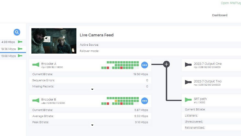Monitoring Hawaii’s Kilauea volcano through a prototype video system
Jul 1, 1999 12:00 PM,
Sandy Calabrese
Ancient Polynesians believed Pele to be their fire goddess, the oneresponsible for the raging fires deep within the Pacific’s volcanoes.According to legend, she was so impressed with the mighty Kilauea volcanothat she made it her permanent home and gave the mountain’s island itsname-Hawaii.
For the past 85 years, Kilauea has also been home to scientists based atthe Hawaiian Volcano Observatory (HVO). The observatory, operated by theUnited States Geological Survey, is perched near the volcano’s crater.>From this vantage point, scientists have amassed information about Kilaueaand its nearby sister volcano, Mauna Loa.
Kilauea, located on Hawaii’s Big Island, is the world’s most activevolcano, having erupted continuously for more than 15 years. Fortunatelyfor scientists, it is also one of the most well behaved volcanoes, slowlypouring its molten lava into the sea rather than exploding violently.
One of the latest methods of monitoring the volcano is a prototype remotevideo telemetry system called the RVTS-1. The recording of video imagesfrom Kilauea began in April 1997. Since that time, the RVTS-1 has provenits value and reliability as an eruption-monitoring device and has added toscientists’ understanding of volcanoes in general and Kilauea in particular.
The key component of the RVTS-1 is a Robot HyperScan digital videotransmission system from Sensormatic Electronics. HyperScan allowsscientists located in the HVO to have a near real-time, high-resolutionvideo display and the ability to record and review the digital images.HyperScan can transmit video via regular phone lines, ISDN, radio orsatellite data links.
Carl Thornber, Ph.D., USGS staff geologist and system designer andinstaller, said, “For the first time, we have the ability to correlate allof our real-time measurements of ground movement and earthquake activitywith actual physical eruption characteristics. Now, with just a glance atour video display, we can see what other measurements mean without sendinghelicopters to investigate.”
In Hawaii, a radio transmitter requiring line-of-sight deployment sends thevideo signals to the observatory. Because of high terrain between thetransmitter and receiver sites, a repeater station is required. The signalsare initially sent from the East Side of Kilauea to a repeater on thesoutheast flank of Mauna Loa, about 21 miles (33.8 km) away. From there,the signals are relayed nearly 10 miles (16.1 km) to the HVO, located onKilauea’s western summit. Radio modems at transmitter, repeater andreceiver sites are FreeWave wire data transceivers from FreeWaveTechnologies. All of the system’s in-line modems transmit data at a 19,200baud rate.
The intense heat and corrosive environment near the volcano’s eruptive ventrequires that electrical instruments and cameras be carefully protected.Temperatures in the area of the transmitter hub can top 300degrees F(148.9degrees C). All equipment is contained in a combination of fiberglassand other cases, including U.S. Army surplus ammunition boxes that aretightly sealed with well-greased gaskets and silicone adhesive around theconnection ports. About once every two weeks, Thornber packs the cases withfresh desiccant and acid absorbers. This has kept the equipment operationaldespite the harsh conditions. Otherwise, the system has been virtuallymaintenance free.
The system’s three cameras are linked to the transmitter hub by up to 100 m(328.1 ft) lengths of coaxial or fiber optic cables. Most cameras are atthe end of 50 m to 75 m (164 ft to 246.1 ft) of heavily insulated coaxialcable. More expensive fiber optic cable is used for longer distances. Thefiber optic is more durable and will not attract lightning, but accordingto Dr. Thornber, there is no discernible difference in the quality ofimages received that can be attributed to the use of either cable type.
At the transmitter hub, one weather-resistant fiberglass chest containsfour 12 V batteries, the HyperScan transmitter, an alarm timer and theFreeWave transceiver. An adjacent 200 W solar panel array charges thebatteries, which power the equipment and nearby cameras. The system canoperate up to two weeks without sunshine.
The HyperScan transmitter converts the cameras’ analog video input intodigital signals. Each image is encoded with date, time and alarminformation before compression by HyperScan’s proprietary compressionroutine and sent via RS-232 output to the radio transceiver. Primary imagefiles are sent in their entirety. Sending only the changes within acamera’s field increases transmission speed of subsequent images. A cameraevent timer from FB Engineering sends an electric pulse to the HyperScantransmitter to create an alarm condition. This causes the transmitter tosend several images from each camera every five minutes.
Thornber said the USGS has tried three different types of cameras at thesite in what he called a trial by fire. Tested were compact CCDsurveillance, stripped-down professional video and desktop computerteleconferencing cameras. Two surveillance camera models were damaged fromthe adverse field conditions. The professional video camera proved sturdybut produced inaccurate color balances. The desktop computer camera was themost durable and offered the best image quality.
The repeater station is located at the top of the Mauna Loa Strip Road,making it convenient to reach by car for servicing. Equipment at the siteincludes an encased FreeWave transceiver connected to a 33 inch (838 mm),omnidirectional antenna, a 12 V battery and a 50 W solar panel.
At the HVO receiver hub, signals are captured by another omnidirectionalantenna and FreeWave radio modem. The modem is connected to the COM port ofa desktop computer with a 200 MHz processor, 9 GB hard drive and Windows NToperating system. The HyperScan receiver software is installed on thecomputer and controls the reception, display, archiving and reviewing ofimages from the remote site.
Thornber said the USGS has chosen to receive and view images from eachcamera site in the highest possible resolution. Images are transmitted at arate of less than four seconds per frame. The pictures are viewed on a 17inch (432 mm), high-resolution monitor. HVO scientists may simultaneouslyview multiple frames from one or more cameras or choose to view asingle-frame picture full-screen.
All alarmed images are stored on the computer’s hard drive. Image files arestored in directories that are changed weekly to keep manageable file sizesof less than 200 MB. A high-capacity tape backup system archives images.
The receiver is located where the HVO staff can view the eruptionconditions at a glance or complete a review of images in the active imagedirectory. The video has also proved popular with several other federalemployees.
The observatory is located within the Hawaii Volcanoes National Park. Oncepark officials saw the video, they asked the HVO to splice the signal sothat the images of Kilauea could be shown to the park’s 2.5 million annualvisitors.
“It has become one of the most exciting displays in the park’s museum,”said Thornber.
By using a video capture card and standard teleconferencing software, theobservatory has also been able to send its video to the USGS’ nationalHazard Information Center, Reston, VA. There it has been viewed by a numberof high-ranking federal officials, including Jack Gibbons, the presidentialscience advisor. The video is also available to the Pacific DisasterCenter, operated by the U.S. Department of Defense in Honolulu.
One of the major roles of the USGS staff at the HVO is providing for publicsafety. According to Thornber, there is an ongoing threat of a Mauna Loaeruption that could endanger major resorts on the island’s Kona Coast, andlast August, a lava flow from Kilauea came within a quarter of a mile (400m) of a residential subdivision located on the mountainside.
“We were able to monitor much of that activity from the observatory,”Thornber said. “We could clearly see burning trees five to seven kilometersfrom the transmitter hub. When we could see things changing on us, wecalled in helicopters to monitor events.”
In the future, Thornber would like to add pan, tilt and zoom capabilitiesto at least one of the cameras. This would enable scientists to monitor amuch wider area and view enlarged coverage of specific sites. Additionally,Thornber would like to make use of HyperScan’s two-way audio feature byplacing a mic arrangement near Kilauea’s eruptive vent.
“Often, the volcano will go into certain modes that can be heard longbefore we see anything by camera,” he said.
Overall, the success of the RVTS-1, put together for about $15,000, willlikely spark an increased use of remote video monitoring of volcanoesworldwide. Thornber said there is already talk within the USGS about usinga similar system to monitor volcanic activity among Alaska’s AleutianIslands.
Meanwhile, back in Hawaii, scientists have yet to catch a glimpse of Pele,but the continuous bubbling lavaand strong smell of sulfur surroundingKilauea give notice that the fire goddess is still dangerously on the job.










